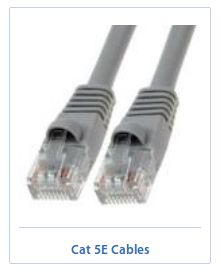How to Choose the Right Ethernet Cable for Industrial Applications?
Have you ever seen an industrial system go kaput? I am sure you must have. What follows is network flaws, chaos, and work delay! Well, just so that you know, nearly 70% of network faults happen due to mediocre network components. In today’s age, if you want to become a successful industrial organization, you need a better data access, reporting systems and enhanced performance. Industrial Ethernet cables help you ensure that your connections work smoothly and network issues remain at bay.
By using the good quality ethernet cables, you will be able to save on a lot of finances, time, and efforts in running your systems smoothly. The pointers given below will help you a lot in selecting the right ethernet cable for your industrial application. Here we go:

Consider the environmental factors
If your infrastructure has control rooms with limited vibrations, you can use solid conductor having high bandwidth capacity. In case of areas with moderate vibrations, it is quite likely that the cables will get an exposure to external materials like rough handling, UV radiation, oil, chemicals, and electronic noises. So, you need to choose accordingly. If the temperature and vibrations are very high, you would need an extremely flexible ethernet cable that can cope with torsion and trailing.
Decide whether to go for Shielded or Unshielded
As the name suggests, shielded ethernet cords come with a protective outer cover and unshielded ones come without them. If your factory has high decibel noise environment, you would need shielded cables. It protects the integrity of signal that the machines emit and keep the unnecessary interferences out. In case you want better durability of your machines and protect it from all the noise, try using the braid or foil combination.
Choose Out of Twisted or Bonded-Pair Conductors
Ethernet cables have two aspects to their characteristics. One, solid vs stranded conductors. And two, twisted versus bonded pair construction. The bonded pair cables make use of a manufacturing technique which attaches the insulation of ethernet cable pairs along their longitudinal axes. This offers resistance against the rigors of installation. By doing so, it also stops gaps from forming between the conductor pairs.
Select Cable based on Your Application
If you do not want long lasting and disastrous losses, you must know how to match your application requirement with a suitable ethernet cable. Conduct ample amount of R&D or get in touch with a company that sells industrial ethernet cables online. As soon as you have a clarity on these things from the experts, you can go ahead with installing. You need to make sure that you are around when your workers install the cable. Only by doing so, you will be able to gain better performance and reliability.
Conclusion
The above steps will ensure that you end up buying a superior quality ethernet cord for your industrial applications. Do you currently use any ethernet cables? What steps do you follow for selecting one? Feel free to share with us.
By using the good quality ethernet cables, you will be able to save on a lot of finances, time, and efforts in running your systems smoothly. The pointers given below will help you a lot in selecting the right ethernet cable for your industrial application. Here we go:

Consider the environmental factors
If your infrastructure has control rooms with limited vibrations, you can use solid conductor having high bandwidth capacity. In case of areas with moderate vibrations, it is quite likely that the cables will get an exposure to external materials like rough handling, UV radiation, oil, chemicals, and electronic noises. So, you need to choose accordingly. If the temperature and vibrations are very high, you would need an extremely flexible ethernet cable that can cope with torsion and trailing.
Decide whether to go for Shielded or Unshielded
As the name suggests, shielded ethernet cords come with a protective outer cover and unshielded ones come without them. If your factory has high decibel noise environment, you would need shielded cables. It protects the integrity of signal that the machines emit and keep the unnecessary interferences out. In case you want better durability of your machines and protect it from all the noise, try using the braid or foil combination.
Choose Out of Twisted or Bonded-Pair Conductors
Ethernet cables have two aspects to their characteristics. One, solid vs stranded conductors. And two, twisted versus bonded pair construction. The bonded pair cables make use of a manufacturing technique which attaches the insulation of ethernet cable pairs along their longitudinal axes. This offers resistance against the rigors of installation. By doing so, it also stops gaps from forming between the conductor pairs.
Select Cable based on Your Application
If you do not want long lasting and disastrous losses, you must know how to match your application requirement with a suitable ethernet cable. Conduct ample amount of R&D or get in touch with a company that sells industrial ethernet cables online. As soon as you have a clarity on these things from the experts, you can go ahead with installing. You need to make sure that you are around when your workers install the cable. Only by doing so, you will be able to gain better performance and reliability.
Conclusion
The above steps will ensure that you end up buying a superior quality ethernet cord for your industrial applications. Do you currently use any ethernet cables? What steps do you follow for selecting one? Feel free to share with us.



Comments
Post a Comment